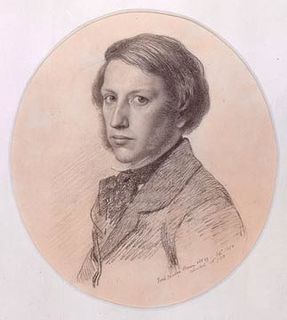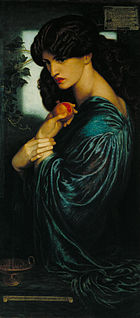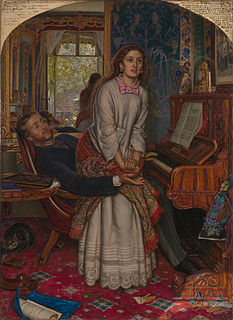
Ford Madox Brown was a British painter of moral and historical subjects, notable for his distinctively graphic and often Hogarthian version of the Pre-Raphaelite style. Arguably, his most notable painting was Work (1852–1865). Brown spent the latter years of his life painting the twelve works known as The Manchester Murals, depicting Mancunian history, for Manchester Town Hall.

The Pre-Raphaelite Brotherhood was a group of English painters, poets, and art critics, founded in 1848 by William Holman Hunt, John Everett Millais, Dante Gabriel Rossetti, William Michael Rossetti, James Collinson, Frederic George Stephens and Thomas Woolner who formed a seven-member "Brotherhood" modelled in part on the Nazarene movement. The Brotherhood was only ever a loose association and their principles were shared by other artists of the time, including Ford Madox Brown, Arthur Hughes and Marie Spartali Stillman. Later followers of the principles of the Brotherhood included Edward Burne-Jones, William Morris and John William Waterhouse.

William Holman Hunt was an English painter and one of the founders of the Pre-Raphaelite Brotherhood. His paintings were notable for their great attention to detail, vivid colour, and elaborate symbolism. These features were influenced by the writings of John Ruskin and Thomas Carlyle, according to whom the world itself should be read as a system of visual signs. For Hunt it was the duty of the artist to reveal the correspondence between sign and fact. Of all the members of the Pre-Raphaelite Brotherhood, Hunt remained most true to their ideals throughout his career. He was always keen to maximise the popular appeal and public visibility of his works.

Richard Wilson was an influential Welsh landscape painter, who worked in Britain and Italy. With George Lambert he is recognised as a pioneer in British art of landscape for its own sake and was described in the Welsh Academy Encyclopedia of Wales as the "most distinguished painter Wales has ever produced and the first to appreciate the aesthetic possibilities of his country". In December 1768 Wilson became one of the founder-members of the Royal Academy. A catalogue raisonné of the artist's work compiled by Paul Spencer-Longhurst is published by the Paul Mellon Centre for Studies in British Art.

Frederic George Stephens was a British art critic, and one of the two 'non-artistic' members of the Pre-Raphaelite Brotherhood.

Thomas Hughes was an English lawyer, judge, politician and author. He is most famous for his novel Tom Brown's School Days (1857), a semi-autobiographical work set at Rugby School, which Hughes had attended. It had a lesser-known sequel, Tom Brown at Oxford (1861).
Joseph Milner (1744–1797), an English evangelical divine, has a reputation particularly for his work on The History of the Church of Christ (1794–1809).
Events from the year 1861 in art.

Sir Michael Ernest Sadler was an English historian, educationalist and university administrator. He worked at Victoria University of Manchester and was the Vice-Chancellor of the University of Leeds. He was also a champion of the English public school system.

The Last of England is an 1855 oil-on-panel painting by Ford Madox Brown depicting two emigrants leaving England to start a new life in Australia with their baby. The painting has an oval format and is in the Birmingham Museum and Art Gallery.

Work (1852–1865) is a painting by Ford Madox Brown that is generally considered to be his most important achievement. It exists in two versions. The painting attempts to portray, both literally and analytically, the totality of the Victorian social system and the transition from a rural to an urban economy. Brown began the painting in 1852 and completed it in 1865, when he set up a special exhibition to show it along with several of his other works. He wrote a detailed catalogue explaining the significance of the picture.
Sir Culling Eardley Eardley, 3rd Baronet was a British Christian campaigner for religious freedom and for the Protestant cause, one of the founders of the Evangelical Alliance.
Francis Hueffer was a German-English writer on music, music critic, and librettist.

Sir Thomas Fairbairn, 2nd Baronet was an English industrialist and art collector.

James Sharples was an English blacksmith and self-taught artist and engraver. He is best known for his work The Forge, which he painted and then engraved in his spare time.

Peter Paul Marshall was a Scottish civil engineer and amateur painter, and a founding partner of the decorative arts firm Morris, Marshall, Faulkner & Co.

Georgiana, Lady Burne-Jones was a painter and engraver, and the second oldest of the Macdonald sisters. She was married to Pre-Raphaelite Brotherhood artist Edward Burne-Jones, and was also the mother of painter Philip Burne-Jones, aunt of novelist Rudyard Kipling and Prime Minister Stanley Baldwin, confidante and friend of George Eliot, William Morris, and John Ruskin. She was a Trustee of the South London Gallery and was elected to the parish Council of Rottingdean, near Brighton in Sussex.

Henry Tanworth Wells was an English miniature and portrait painter. He was a member of the Pre-Raphaelite circle though he painted in the academic style.

Lucy Madox Brown Rossetti was a British artist, author, and model associated with the Pre-Raphaelites. She was married to the writer and art critic William Michael Rossetti.
James Peel was an English landscape painter.















